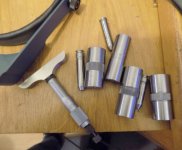C
Clark
Guest
I thought the go gauge would come up level with the top of the case gauge. I was wrong. I looked into it further.
I thought that in SAAMI drawings tolerance there would be a range for cartridges and a range for chambers with no overlap, so there was guaranteed clearance.
I was wrong. It is up to a 0.004" interference fit.
I thought the two levels on top of the case gauge would represent the min and max lengths for a cartridge.
I was wrong. It is from the longest to ~~halfway to the shortest the cartridge can be.
I am now thinking I should keep on headspacing rifles so the bolt just closes on the go gauge.
But I will be using the case gauge only for relative measurements, not as absolute, to measure brass, to adjust sizer dies.
*************************************
The 243 cartridge, per SAAMI is 1.634 -0.007"
The 243 chamber, per SAAMI, is 1.630 +0.010"
---------------
0.0040" overlap
243-308 1.630 go gauge dropped into a
243 Wilson case gauge
Down 0.004" from the top of 0.0045" twin levels
*************************************************
The 6mm cartridge per SAAMI is 1.7807 -0.0070"
The 6mm chamber per SAAMI is 1.7767 +0.0100"
-----------
0.0040" overlap
6mm Rem go Manson dropped into a
6mm Remington Wilson case gauge
Down 0.003" from the top of 0.0045" twin levels
*******************************************
The 270 cartridge per SAAMI is 2.0526 -.0070"
The 270 chamber per SAAMI is 2.0487 +0.0100"
------------------
0.0039" overlap
270 30-06 25-06 Forster go gauge 2.0487 dropped in a
Forster-Appelt 270 Win case gauge
Down 0.0035" from the top of 0.0055" twin levels
************************************************
The 30-06 cartridge per SAAMI is 2.0526 -.0070"
The 30-06 chamber per SAAMI is 2.0487 +0.0100"
------------------
0.0039" overlap
270 30-06 25-06 Forster go gauge 2.0487 dropped in a
30-06 Wilson case gauge
Down 0.0055" from the top of 0.0050" twin levels
I thought that in SAAMI drawings tolerance there would be a range for cartridges and a range for chambers with no overlap, so there was guaranteed clearance.
I was wrong. It is up to a 0.004" interference fit.
I thought the two levels on top of the case gauge would represent the min and max lengths for a cartridge.
I was wrong. It is from the longest to ~~halfway to the shortest the cartridge can be.
I am now thinking I should keep on headspacing rifles so the bolt just closes on the go gauge.
But I will be using the case gauge only for relative measurements, not as absolute, to measure brass, to adjust sizer dies.
*************************************
The 243 cartridge, per SAAMI is 1.634 -0.007"
The 243 chamber, per SAAMI, is 1.630 +0.010"
---------------
0.0040" overlap
243-308 1.630 go gauge dropped into a
243 Wilson case gauge
Down 0.004" from the top of 0.0045" twin levels
*************************************************
The 6mm cartridge per SAAMI is 1.7807 -0.0070"
The 6mm chamber per SAAMI is 1.7767 +0.0100"
-----------
0.0040" overlap
6mm Rem go Manson dropped into a
6mm Remington Wilson case gauge
Down 0.003" from the top of 0.0045" twin levels
*******************************************
The 270 cartridge per SAAMI is 2.0526 -.0070"
The 270 chamber per SAAMI is 2.0487 +0.0100"
------------------
0.0039" overlap
270 30-06 25-06 Forster go gauge 2.0487 dropped in a
Forster-Appelt 270 Win case gauge
Down 0.0035" from the top of 0.0055" twin levels
************************************************
The 30-06 cartridge per SAAMI is 2.0526 -.0070"
The 30-06 chamber per SAAMI is 2.0487 +0.0100"
------------------
0.0039" overlap
270 30-06 25-06 Forster go gauge 2.0487 dropped in a
30-06 Wilson case gauge
Down 0.0055" from the top of 0.0050" twin levels



